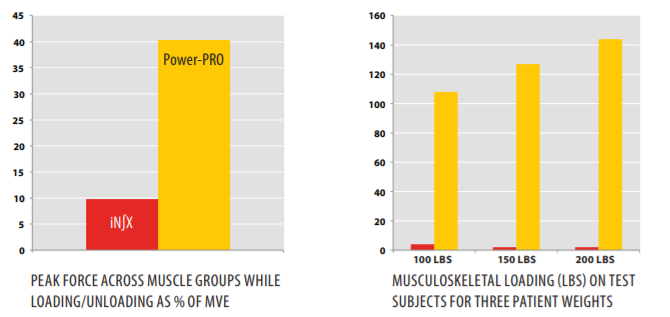INDEPENDENT ANALYSIS
EMS is a high risk business for individuals and agencies alike. EMS providers experience high rates of musculoskeletal injury, most commonly sprains, strains, or back injuries. A typical injury costs over $20,000 in direct expenses and results in an average 90 days of lost work time. Independent research has proven that operators using the iN∫X™ Integrated Patient Handling & Loading System™ do not have to support the weight of the cot and patient during loading and unloading, effectively reducing and eliminating these risks.
Power Cots Reduce Injury
Research has shown the most common cause of lifting oriented injuries, like what we see in EMS, is cumulative trauma; repetitive loading of the joints and spine which leads to tissue fatigue and eventual tissue failure.1 Preventing injury requires greatly reducing or eliminating repetitive loading forces. EMS specific research has shown that power cots reduce compression forces on the body when raising and lowering a patient,5 while other research has shown that implementing power cots across an agency reduces occupational injury rates and incidents from raising and lowering.3 This research also demonstrates reduced injury rates corresponding to lower workers compensation claims and lost work days.4
Rationale
While power cots reduce injury from raising and lowering, providers are still exposed to injury risks while loading and unloading a cot. Understanding this, FERNO recognized the need to create a device that would eliminate loading forces across the patient handling cycle while both raising and lowering, and loading and unloading. The iN∫X Integrated Patient Handling & Loading System was created to meet this need.
The Experiment
To confirm the reduction in loading and unloading forces, independent ergonomic experts studied EMTs and paramedics loading and unloading variable patient weights (100/150/200lbs) from a simulated ambulance deck while comparing two different types of power ambulance cots: The FERNO iN∫X and the Stryker® Power-PRO®. Researchers tested the effect of cot and weight conditions on average and peak muscle activity (arm, shoulders, and back) measured by Maximum Voluntary Exertion (MVE) normalized across all test subjects. Researchers also tested peak and static loads imposed on the subject while handling the cot, and subjects’ rating of perceived exertion.2
Experimental Results
Data collected showed the iN∫X consistently elicited lower muscle activity than the Power-PRO. For all three patient weights tested, muscle activity did not increase as weight on the iN∫X increased, while muscle activity increased as weight on the Power-PRO increased. Average and peak muscle activity averaged less than 10% MVE for the iN∫X at all weights tested, while muscle activity for the Power-PRO was 2-12 times greater for each muscle group, with peak activity as high as 40% of MVE.2Force plate data clearly showed the subjects did not support the weight of the loaded iN∫X while the legs were extending or retracting during tasks across all weight conditions. When using the Power-PRO subjects held an average of 126 lbs across the three weight conditions while performing the same tasks. For each additional 50 lbs of patient weight on the Power-PRO, subjects experienced a 17 lb increase in external load, with an average of 180 lbs peak force when handling a 200 lb patient load.2
Test subjects' ratings of perceived exertion (RPE) were lower for the iN∫X than the Power-PRO, including lower ratings for the iN∫X loaded with the greatest test weight when compared to ratings for the Power-PRO loaded with the lowest test weight.
Conclusion
The iN∫X design has a direct impact on the external loads operators experience, internal muscle activation required to counteract those loads, and subjective perceptions of exertion. Operators do not have to support the weight of the cot and patient during loading and unloading and the iN∫X effectively nullifies the effects from increases in patient weight 2.1. MCGILL, S.M., 1997, The Biomechanics of Low Back Injury: Implications on Current Practice in Industry and the Clinic. Biomechanics, 30, 465-474.
2. SOMMERICH, C.M., LAVENDER, S.A., 2013, A biomechanical and subjective assessment and comparison of two powered ambulance cots. Final Report; Department of Integrated Systems Engineering, The Ohio State University
3. STUDNEK, J.R., CRAWFORD, J. and FERNANDEZ, A.R., 2012, Evaluation of Occupational Injuries in an Urban Emergency Medical Services System Before and After Implementation of Electrically Powered Stretchers. Applied Ergonomics, 43, 198-202.
4. FREDERICKS, T.K., BUTT, S.E. and HOVENKAMP, A., 2009, The impact of gurney design on EMS personnel. Proceedings of XXIst Annual International Occupational Ergonomics and Safety Conference, Dallas, TX: International Society of Occupational Ergonomics and Safety, 112-117.
5. FREDERICKS, T.K., BUTT, S.E., HARMS, K.S., and BURNS, J.D., 2013 Evaluation of Medical Cot Design Considering the Biomechanical Impact on Emergency Response Personnel. The XXVth Annual Occupational Ergonomics and Safety Conference, June 6-7, 2013

